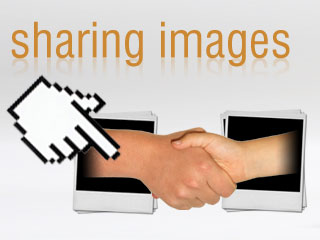Watch: this short video that describes Online Photo Sharing in Plain English to get an introduction to how it all works.
Flickr is a website that allows users to upload digital pictures from their computer and share them with just their friends or everyone. Users can "tag" an image with key words that describe the picture. This allows people to search Flickr for pictures that interest them by entering tag words into the search window.
 Discover: Go to Flickr and type "Midland Western Australia" into the search box at the top of the screen and take a look at the pictures that have been tagged with Midland Western Australia. Search for your community. What do you think about what you find?
Discover: Go to Flickr and type "Midland Western Australia" into the search box at the top of the screen and take a look at the pictures that have been tagged with Midland Western Australia. Search for your community. What do you think about what you find?You have looked for some work stuff; now let's look for fun stuff. Try looking for 'vegemite', 'lamington', 'bad library signs'...you get the idea, try some of your own key words (tags). There is also the ability to view Flickr search results as an automatic slideshow (definition) using the "View: Slideshow" link located in the upper-right.
So how are libraries using photo sharing?
- The National Library of Australia is using Flickr as a way of engaging people around the country in building the collection. See Picture Australia: Ourtown as an example - scroll down to read the tagging guidelines. Also this week Kathryn Greenhill interviewed Paul Hagan, senior web designer for the National Library of Australia, on new ways the National Library is using Flickr. Is this a project our libraries can become involved with?
- Lake Country Public Library put up photos each week of the renovations to the Munster Library branch.
- @yourlibrary.org held a competition for designing a library bag.
- Wellington City Libraries in NZ has a Flickr Pool of patrons with cards.
Flickr Groups
Flickr makes use of groups. Groups are communities of like minded photo posters. And, yes, there are quite a few groups with a library theme. Take a look at their FAQ page on groups for more information on how they work.
Creative Commons
How would you feel if someone took your photo and made a poster out of it and sold it? Not too happy I would guess, and rightfully so. To help protect the artist's rights, Creative Commons was developed to provide artists with the ability to put work out into cyber space but still have control of how their work is consumed by the public. Here is more info about Creative Commons from Wikipedia. The video Building on the Past demonstrates what Creative Commons is, and how it works.
Examples of websites that use Creative Commons to protect their work:
The original version of Learning 2.0 was created by the Public Library of Charlotte & Mecklenburg County. They licensed the course so that other libraries could use it. By agreeing to their licence terms in Creative Commons, we also agree to allow others to use the content of this course. We also have permission to build on the work of New South Wales State Library and Murdoch University. You can see our licence at the bottom of this page in the "credits" section.
Look at this photo on Flickr. If you look to the right of the picture, under Licence, you will see two small icons and the link "some rights reserved". If you click on the link you will see how New South Wales State Library has used Creative Commons to both protect and share this photographic work.
Etiquette
A quick word about photo posting etiquette. When posting identifiable photos of other people (especially minors) is it advisable to get the person's permission before posting their photo in a publicly accessible place like Flickr. Never upload pictures that weren't taken by you unless you have the photographer's consent and always give credit when you include photos taken by someone else in your blog.
Also please check if your Council has an internal policy on using photos. For example, City of Swan has specific permission forms that require the signature of anyone in the photograph (or parent/guardian of minors) before we can use the photo in any official capacity. They also recommend we do not use photographs that are over three years old.
Finally, please remember that any photograph you share publicly online can be searched and found by anyone. And I do mean anyone, including family members, your library management and prospective employers. Please think before uploading any content that could be embarressing for you or anyone else. Please watch Protecting Reputations Online in Plain English. If you have any questions, or you are concerned your photograph may be inappropriate, please contact your library representative for more information.
Explore: Have a good look around Flickr and discover an interesting image that you want to write about in your blog. Be sure to include either a link to the image or a copy of the image itself in your blog posting. If you want to embed the photo in your blog post, use the Blogger's photo upload tool, or watch this video or ask your library representative.
If you don't know what to write about in your blog this week, think about how your library could use Flickr and include a photograph that illustrates your idea.
Also don't forget to explore other participants' blogs this week. Try to post a comment on at least five blogs each week.
Next week: Following RSS Aggregators/Feeds...
Great if you have all the time in the world. Speed of your connection is fast - otherwise unbelievably frustrating
ReplyDeleteI really enjoyed this segment of the online training.
ReplyDelete